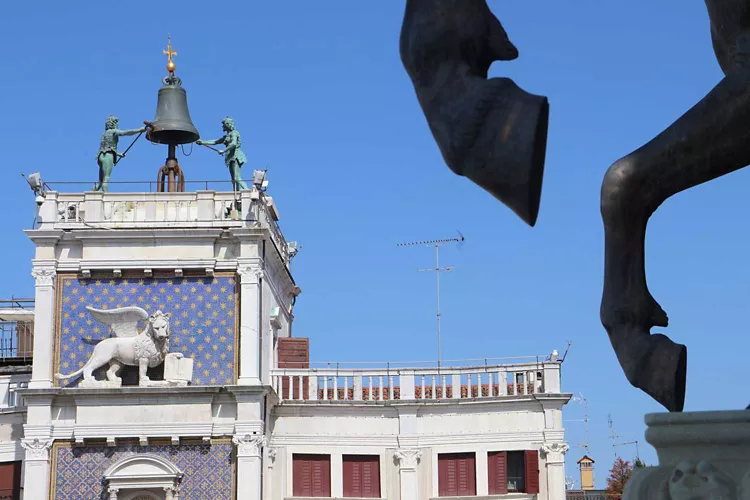This content was automatically translated. View the original text.

Overview
Venice: the Clock Tower and the “imperfect” time of the Moors
Also called the Clock Tower of the Moors, due to the colour of the bronze burnished by time of the two giant automata that strike its chimes, the Venice Clock Tower is one of the three most iconic monuments of St Mark's Square. A gateway to the square that represented the secular and spiritual power of the Serenissima for those arriving from its main shopping district, the Mercerie, the Tower, with its complex gears, architecture and elegant friezes, is a masterpiece of engineering and beauty that has marked the times, traditions and history of the city on the Lagoon for over five centuries.
Its origins: the symbol of a power in step with the times
Erected in 1499 at the behest of the Republic of Venice and attributed to the work of the architect Mauro Codussi, the tower was enriched by the Ranieri brothers, skilled watchmakers from Reggio Emilia, with a clock featuring a complex automation system, one of the very few of its kind in the world, to reflect the idea of a Venetian state in keeping with the times.
A legend, disproved by historical sources, relates that the Maggior Consiglio, after paying the clock designers, ordered their eyes to be gouged out so that they could never recreate a similar work again. Thank goodness, the Ranieri brothers survived their creation and, indeed, took care of the clock's upkeep for a long time.
The tower was enlarged in 1506 with the addition of the two elegant side wings; in 1750, after several maintenance works, the clock machine was finally changed and the two side wings were raised, to which balustrades were added. In 1797, when the Republic of Venice was occupied by the French, the original statue of the doge genuflected next to the lion at the top of the Tower was vandalised and destroyed, as a sign of disrespect.
A four-storey masterpiece
The building, which towers over the entrance to St. Mark's Square like a triumphal arch, is divided into four floors: the first is occupied by the clock face; on the second there is a recess containing a Madonna and Child with two small doors on its sides; on the third there is a winged St. Mark's lion, whose left paw is grasping the Gospel. Next to it, before French domination, was the figure of the kneeling doge. If you look up, you can also see, on the top floor of the Tower, the terrace, surrounded by an elegant stone balustrade: in the middle is the large bell with the Moors.
A complex astronomical clock, futuristic for its time
Second perhaps only to London's Big Ben in popularity, the Tower Clock is a treasure in gold and enamel.
On the south face, the one facing the square, the fixed marble circle marks the hours in Roman numerals. The mobile part, consisting of a larger ring, illustrates the signs of the zodiac and constellations, the months and the numbers of days.
On a thinner ring is fixed a hand in the shape of the sun with a longer radius indicating the hours. The inner disc depicts the earth, in the centre, and the moon, which rotates on its axis indicating its various phases. The current dial has been simplified from the original one, which showed the planets arranged according to the Ptolemaic system.
The North quadrant, facing the Mercerie, has a similar structure of concentric circles: the outer circle with the hours and the inner circle in blue mosaic dotted with gold stars; in the centre a mobile disk with flaming rays marks the hours.
The intermittent procession of the Magi
The loggia on the second floor, in which the Madonna and Child is depicted, is regulated by a curious carillon mechanism. When the Tower was built, the wooden statues of the three Magi, escorted by an angel holding a trumpet, came in and out of the movable doors next to the Madonna at every hour, each time parading before her. Wear and tear soon jammed their delicate mechanisms, which were only removed and restored in 1755. Since then they have been operational again, but to see them in motion you must have the patience to wait for the feasts of the Epiphany and Ascension Day, when the carillon is set in motion again.
The Human Clock of the Moors
Despite the nickname given to it by the Venetians, the do’ mori (two Moors), in reality the two moving statues at the top of the Tower depict two shepherds, who mark the hours by striking the large bell with a mallet. The one with the beard is called il vecchio (the old man), and the other is known as the il giovane (young man).
In spite of the rigorous gears that move them, the Moors are, as you will discover, anything but punctual, faithful rather to a symbolic interpretation of time: the old man strikes the hours two minutes ahead of time, thus alluding to the past, while the young man's chime comes two minutes later, to indicate the future.
A tour to discover the gears and the city from above
If you feel like visiting the Tower from the inside and taking a closer look at its complex gears - the clock and astronomical machine, the statues of the Three Wise Men, the Moors' train - and finally going out onto the terraces, from which you can enjoy a spectacular view of St Mark's Square and the entire Lagoon, remember that the visit is by appointment only and takes place with a specialist guide.
For more information
torreorologio.visitmuve.it